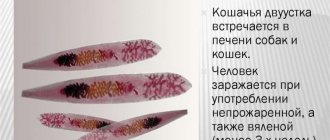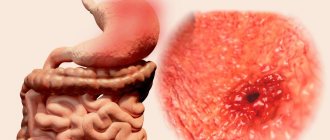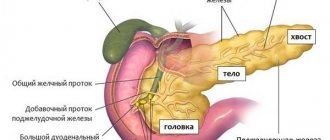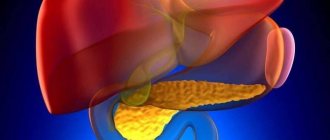What herbs to take for pancreatitis and cholecystitis? We'll talk about this in this article. It is not for nothing that pancreatitis is considered one of the most dangerous diseases of the digestive system in the human body.
With inflammation of the pancreas, necrosis of living tissue of the pancreas, as well as neighboring organs, often occurs. There are about 200 causes of this disease, including nutritional disorders, diseases of the gastrointestinal tract and heredity.
Diseases of the gastrointestinal tract that provoke pancreatitis include such pathologies as cholecystitis - blockage of the bile ducts with stones. For many years in a row, people have been looking for folk remedies for pancreatitis and cholecystitis, which will help eliminate the symptoms of diseases in the early stages and avoid the development of pathologies into more severe forms.
At all times, folk medicine has been treated with particular caution, because herbs can not only cure one disease, but also provoke side effects and the development of another disease. Therefore, experts always advise consulting with doctors before starting traditional medicine treatment. After a thorough examination by doctors, you can visually draw a picture of the disease and plan further treatment options, including unconventional methods.
Symptoms of cholecystopancreatitis
To understand when you need to seek help from doctors, you need to know the first manifestations of the disease. As a rule, pancreatitis in patients appears due to an advanced form of cholecystitis. The manifestations of diseases are quite similar to each other and together deprive a person of his ability to work. Main symptoms:
Pain
With inflammation of the pancreas and cholecystitis, the pain will be localized under the ribs on the right side. Inflammation of the gallbladder is characterized by cramping urges, pain during the inflammatory process of the pancreas is constant and severe.
Pain syndrome is more pronounced in acute forms of pathology. Sometimes sensations can affect not only the abdominal cavity, but also the spine. In this case, you should immediately call an ambulance, as this indicates a severe relapse. It is dangerous to use unconventional methods of treatment, since only qualified medical care can relieve symptoms and unblock the blockage of bile and enzymes.
Nausea
Nausea accompanies the patient when two diseases or one of them develops at once. Feelings of nausea intensify after eating. You should avoid foods rich in fats and carbohydrates. Constant nausea may indicate a chronic course of pathologies, so it is important to properly plan your diet. Diet No. 5 is best, which includes only healthy, easily digestible foods.
Vomit
Vomiting occurs with varying intensity and duration. This indicates the stage of development of the disease. Vomiting occurs when overeating, abuse of fried, salty, spicy, sour foods. When vomiting there is always pain. In severe and acute forms, the urge is systematic and does not bring relief to the patient, food is not digested.
Change in skin color
Problems with the digestive system lead to the fact that the body does not fully receive nutrients and vitamins. In addition, inflammation of the pancreas and gallbladder poisons the body with toxins that the liver is not able to remove on its own.
In this case, the patient’s complexion begins to change, it becomes grayish and stale. In some cases, obstructive jaundice may even occur, when the palms and eyelids become the corresponding color.
Folk remedies for pancreatitis and cholecystitis do not always help to cope with the full list of manifestations of diseases, so they should be started after consultation with the attending physician.
Properties of various herbs used for cholecystitis and pancreatitis
Herbs for cholecystitis are used for various purposes. Therefore, herbal medicine is selected for each patient individually, depending on the problems he has with the gallbladder and ducts, as well as the presence of certain concomitant pathologies. Since the most common concomitant disease with cholecystitis is pancreatitis, the main task of herbal medicine is to combat bile stagnation and provide an anti-inflammatory effect on the diseased pancreas and gallbladder. Therefore, most often medicinal plants are used as follows:
- to eliminate stagnation of bile, choleretic herbs are used for cholecystitis;
- for spasms of the biliary tract, the use of agents with an antispasmodic effect is indicated;
- to combat microorganisms that provoke the inflammatory process, herbs with antiprotozoal, antimicrobial and antibacterial effects are used;
- for general disorders of the liver - drugs with hepatoprotective properties;
- in the presence of stones - products with a litholytic effect.
Attention! Most modern doctors have a negative attitude towards the possibility of dissolving gallstones by any means, since the separated small parts can clog the bile ducts or cause injury to the organ with sharp edges. This may be unsafe for the health and life of the patient.
Of course, most often patients need to speed up the processes of production and excretion of bile, so the most popular are herbs with pronounced choleretic properties. These include:
- sandy immortelle,
- common tansy,
- field mint,
- barberry,
- peppermint,
- centaury,
- Amur velvet,
- birch leaves,
- corn columns.
But different plants have different types of choleretic properties. Therefore they are divided into 2 groups:
- Choleretics that enhance the outflow of bile by increasing the mass fraction of water in its composition. Representatives of this species are all varieties of mint and birch.
- Cholekinetics, which actively expel bile by increasing the tone of the biliary tract and gallbladder. The most striking cholekinetics can be called corn silk and tansy.
Accordingly, treatment of cholecystitis with herbs is carried out differently in different cases. For example, with hypertensive biliary dyskinesia and the presence of stones in the bladder, only choleretics can be used, since taking cholekinetics can provoke the movement of stones and increased pain. On the contrary, for acalculous cholecystitis with atony of the gallbladder itself and its ducts, cholekinetics should be used. They will increase the tone of these organs and provoke increased excretion of stagnant bile.
Attention! You need to be quite careful when using Amur barberry, Chinese capillary and sandy immortelle, since they are characterized by a mixed effect.
The following have pronounced antispasmodic properties:
- anise,
- swamp cudweed,
- fragrant dill,
- common fennel,
- caraway,
- cinquefoil goose,
- St. John's wort,
- rhomboid cross,
- pharmaceutical camomile.
Attention! Particular attention should be paid to the use of products based on henbane, belladonna and stinking datura, since they contain highly toxic substances.
Chamomile
Chamomile is used very widely for cholecystitis. Based on it, you can prepare healing teas, infusions, and also use it as one of the components of anti-inflammatory and antispasmodic medicinal preparations. An interesting way to use warm chamomile infusion is to administer it as an enema.
Chamomile flowers are a truly universal remedy for almost all diseases.
Plantain
Psyllium seeds help reduce cholesterol levels, which is one of the main components of gallstones, and have a powerful anti-inflammatory effect. Therefore, popularly called flea seeds, plantain seeds can be added to any dishes in quantities not exceeding 4 tablespoons per day.
An infusion of plantain leaves has choleretic properties. But taking this remedy is not recommended for patients with stomach diseases and a tendency to blood clots.
Milk thistle
Milk thistle is used for cholecystitis because of its anti-inflammatory and hepatoprotective properties. As a rule, patients are recommended to use crushed milk thistle seeds, which are taken before meals. A decoction of the dried root of the plant is also used to treat inflammation of the gallbladder.
Milk thistle oil has earned even wider use. It has antispasmodic, choleretic, antimicrobial and anti-inflammatory properties. Thus, it is an almost universal remedy with almost no contraindications. But you shouldn’t expect an immediate effect from using milk thistle oil, which is its main drawback.
Chicory
The use of chicory has a beneficial effect on the functioning of the liver and gall bladder. It is usually recommended to take decoctions and tinctures prepared from the flowers, roots and seeds of this plant, and fresh juice can act as an excellent choleretic agent. Widespread chicory coffee also has a beneficial effect on the functioning of the gallbladder.
For cholecystitis, not only chicory root can be used, but also its above-ground parts
Important: chicory coffee can cause the movement of stones, so it can be used for the calculous form of cholecystitis only with the permission of a doctor.
Wormwood for inflammation of the pancreas and gall bladder
Herbs for cholecystitis and pancreatitis have been used since ancient times; now this practice is also not considered an exception. Wormwood is considered a very useful and healing plant for these ailments.
Wormwood is valued primarily for its properties. It contains sesquiterpenes, which gives the herb a bitter taste. It is this component that helps improve gastric motility, causes a choleretic effect and helps remove stones from the bile ducts.
The herb is also rich in green essential oil, which helps enzymes break down food. Bitter wormwood normalizes the amount of gases in the digestive system, while reducing discomfort for the patient.
You can either prepare bitter wormwood yourself by picking the leaves and from the roots until the flowering period, or you can buy it at the nearest pharmacy.
A decoction is mainly prepared from wormwood; it tastes quite bitter and unpleasant, but it has a clear effect in the early stages of the formation of the disease.
To prepare the decoction, take a tablespoon of fresh crushed leaves or half a spoon of purchased dry ones. Pour 200 grams of boiling water and cover tightly with a lid and place in a warm place so that the drink infuses. You need to take it three times a day, one tablespoon before meals.
In acute pancreatitis or cholecystitis, this method is contraindicated - only drug treatment.
How to treat pancreatitis with oatmeal jelly
Oatmeal jelly, which should be used in the morning instead of breakfast, will help cure pancreatitis. (HLS 2001, No. 5, p. 4)
Sprout the oat grains for 24 hours, dry them, and grind them into flour. 1 tbsp. l. pour flour with 1 glass of water, bring to a boil while stirring, boil for 2 minutes. Store the jelly for no more than 1 hour. (HLS 2011, No. 10, p. 14) (2006, No. 13, p. 17)
Here is another recipe for pancreatitis using oats:
For gastrointestinal diseases aggravated by pancreatitis, oat decoction is especially useful. Pour 1 glass of oats into 1 liter of water, leave for 12 hours, bring to a boil and boil for 30 minutes with the lid tightly closed. Wrap and leave for 12 hours, filter and bring the volume to 1 liter. You need to drink 100-150 ml 3 times a day 20-30 minutes before meals. The course of treatment with oats is 1 month. (HLS 2006, No. 13, p. 17)
A pendulum helped get rid of pain in the pancreas
The man had pancreas pain since his youth. Doctors told him that pancreatitis cannot be cured, only the patient’s condition can be alleviated. Over the years, he became convinced of this - no medications or procedures helped him avoid attacks of pain. After reading Yuri Nikolaev’s book “Fasting for Health,” I fasted for 14 days, my condition improved significantly. And since then, as soon as an attack of pancreatitis begins, the man resorts to fasting.
He then became acquainted with food diagnostics using a pendulum. The greatest amplitude of fluctuations occurs for sugar and milk. He eliminated these foods from his diet, and since then he has had no attacks of pain. Different foods trigger attacks in different people, so you need to use a pendulum to determine what is and is not right for you. (HLS 2001, No. 13, p. 17)
Yarrow for pancreatitis and cholecystitis
Another plant that helps fight the symptoms of pancreatitis and cholecystitis is yarrow. It, like wormwood, has a strong bitterness, which is why it is often combined with other medicinal herbs such as chamomile and St. John's wort.
Yarrow is rich in essential oils, flavonoids, terpenoids, vitamins and acids. Herbal infusions, extracts and extracts are used to treat pathologies.
Yarrow improves stomach function by helping even small amounts of enzymes cope with the digestive process. It reduces the aggressiveness of gastric juice, reducing stomach irritation when eating. This herb also has a relaxing effect, which allows you to release small stones from the bile ducts and partially restore the functioning of the organ.
At home, the easiest way is to make an infusion of yarrow. To do this, take a tablespoon of chamomile flowers, a tablespoon of St. John's wort and a spoonful of crushed yarrow. All this is poured with a liter of boiling water and left for 2 hours to fully cook. Take a third of a glass before meals.
Bouquet remedy: gastritis – cholecystitis – pancreatitis
These three diseases often occur together and develop one after another. This bouquet can be cured at home, although not easy, but doable if desired.
Treatment consists of three courses. In periods I and III (each of them lasts 12 days), pheonine is taken. Only 1.5 liters are needed for treatment. This is how they prepare it. Take a 3-liter enamel pan and fill 1/3 with well-washed and crushed hawthorn roots. Fill 2/3 with horse sorrel roots. Some types of horse sorrel have bitter roots - they are not suitable for treatment. The roots are poured with cold water and left for 1 hour.
Then cook after boiling over low heat for 5-7 hours. Then the medicine is cooled and filtered. The roots are mixed and filled with water again. They have been boiling for 3-5 hours. Cool and filter. Both of these decoctions are combined and boiled for 5 minutes. Feonin is ready. Pheonine is taken in the following order: 5 days – 1 tbsp. l. three times a day half an hour before meals; 4 days – 1.5 tbsp. l. , 3 days, 2 tbsp. l. according to the same scheme.
During the second period of treatment, drink a decoction of rose hips and pine needles for 5-7 days. Take 3.5 l. saucepan, add 0.5 kg of dried rose hips, fill to the top with cold water, leave for half an hour, then bring to a boil, boil for 10 minutes and leave for 2 hours. Mash the berries with a masher and put the broth back on the fire, boil for 5 minutes. Then add 100 g of green needles (spruce, pine or fir), boil for 5 minutes, cool, filter. It turns out about three liters of broth. Pour it into a jar and add three tablespoons of honey. It is taken 3 times a day, a glass after meals. Store both medications in the refrigerator and warm the required portion to room temperature before use.
If the disease is very advanced and the acidity is very high, then before treating pancreatitis with these remedies, take 100 g of fresh carrot juice in the morning on an empty stomach for 10 days.
Thus, treatment lasts about a month. After which it is possible to cope with all three diseases. (HLS 2001, No. 14, p. 15)
Traditional treatment of pancreatitis with herbs
The woman became seriously ill, turned yellow in a week and lost 13 kg. For 4 months they could not make a diagnosis - the tests were good. Only tomography showed cysts in the head of the pancreas. Then they diagnosed acute pancreatitis. By this time, the patient’s digestive system no longer worked; lifting even a 1 kg load caused unbearable pain under the ribs. Upon discharge, the doctor said that I would have to take enzymes and pills for the rest of my life and go for examination every six months. One of the doctors advised me to use herbs and go to church in addition to pills.
The woman threw away all the pills and began drinking herbal tea and going to church. I carefully monitored my diet – how my body reacted to various foods. I found out that even a drop of milk causes pain in the pancreas for many days. And also lifting weights. At first I ate only boiled, chopped food and excluded sweets. Then she noticed that red currant and gooseberry jam did not cause pain (she had low acidity). Gradually my health returned.
12 years have passed, the woman has never consulted a doctor about pancreatitis. He already eats whatever he wants and carries bags. I told my friends who suffered from pancreatitis about my method, and this herbal collection also helped them.
Here is the recipe: mix corn silk, calendula, field chamomile, peppermint, plantain (at low acidity) in equal proportions. 1 tsp. collection, pour 800 ml of boiling water. Warm up for 15 minutes in a water bath. Leave for 45 minutes, strain. Store in the refrigerator for no more than 5 days.
Take 1/4 cup of infusion 3 times a day, 15 minutes before meals, diluting it with 3/4 cup of warm water. (HLS 2003, No. 10, p. 19)
Traditional treatment of pancreatitis with cabbage brine
After severe stress, the woman’s sugar suddenly rose, and pancreatitis of the pancreas was discovered. On the advice of an experienced doctor, the patient began drinking sauerkraut juice instead of pancreatin. I took calendula and befungin at the same time. After a month of this treatment of pancreatitis with folk remedies, the sugar returned to normal and the pain in the pancreas disappeared.
I fermented the cabbage myself, without spices, just with salt. For 5 days after chopping and fermenting, it remained warm. Then I decanted the juice and put it in the refrigerator; I did not eat the cabbage itself (probably you can squeeze the juice out of sauerkraut using a juicer). I took sauerkraut juice 1-2 tbsp. l. before eating. 30 minutes before meals, 3 times a day, I took calendula tincture (1 tsp per 50 g of water) and befungin (1 tbsp per glass of water) (Healthy Lifestyle 2003, No. 14, p. 27)
Herbal treatment according to the prescription of Dr. Lyubimova
The following folk remedy is very effective in treating the pancreas: mix in equal proportions the roots of elecampane, burdock, wormwood, dried grass, horsetail, sage, string, calendula and chamomile flowers. 1 tbsp. l. collection, pour 1 cup of boiling water, boil for 2 minutes, leave for 1 hour. Take 100 g 30 minutes before meals 3 times a day. The course of treatment is 1 month. (HLS 2003, No. 18, p. 20)
This collection helps prevent destruction of the pancreas during chronic pancreatitis and avoid complications. (2009, no. 18, p. 15)
Pancreatitis and cholecystitis - treatment using the Bolotov method
Using the celandine enzyme in combination with taking cabbage cakes gives relief from pancreatitis and cholecystitis in 2 weeks.
Recipe for celandine enzyme: 3 liters of water, 1/2 cup of dry celandine herb, placed in a gauze bag with a weight, 1 cup of sugar and 1 tbsp. l. sour cream. Mix all the ingredients, lower the bag of celandine to the bottom, leave for 2 weeks. Stir the contents every day and remove mold from the surface. Then pour 1 liter of kvass from the jar, add 1 liter of water and 1/2 cup of sugar. Store the poured enzyme in the refrigerator and take 1/3-1/2 cup 3 times a day 30 minutes before meals (start with 1 tablespoon and gradually increase the dose).
At this time, the next portion of the enzyme will mature. You can drain the kvass and add water 3-4 times. Then prepare a fresh infusion with a new portion of celandine. Cabbage cakes are taken in the morning on an empty stomach: the juice is squeezed out in a juicer, and the resulting cake is eaten. The juice is given to household members or drunk after 2 hours. Cake taken on an empty stomach collects excess bile in the stomach, eliminates stagnation of digestive juices in the pancreas, which provokes its inflammation, and restores the functioning of the valves between the stomach and duodenum. (HLS 2004, No. 4, pp. 14-15)
Potato and carrot juice in folk remedies for treating pancreatitis
Squeeze the juice from 2-3 large potatoes with skins and 1-2 carrots. You should get about 200 g of juice. You need to drink it on an empty stomach and lie down for half an hour. In another half hour we need to have breakfast.
Drink juice for 7 days, take a week off. In total, carry out three such courses of treatment. This is a very effective remedy for pancreatitis (HLS 2005, No. 10, p. 29). You can also take one potato juice: half a glass on an empty stomach. 10 days to drink, 10 days break (HLS 2011, No. 1, p. 28,).
Treatment of chronic pancreatitis with goat milk
The woman had chronic pancreatitis for many years. After reading about the healing properties of goat's milk, she got goats. After I started drinking goat milk, I forgot about my illness. (HLS 2005, No. 21, p. 30)
Auxiliary herbs
Folk remedies for pancreatitis and cholecystitis are often combined with each other to enhance the effect of treatment. It is important to know that not all patients without allergic reactions take different herbs and medications, therefore, if side effects from a medicine are detected, it is better to replace it with another.
So, to treat inflammatory processes of the gallbladder and pancreas, violet flowers, linden blossom, peppermint, and castor oil are used.
It is important to listen carefully to your body after each use of folk remedies. If you experience nausea, rash, or fever, you should immediately stop taking the drug.
In folk medicine, the main thing is not to overdo it, since the desire to quickly heal and increasing doses often leads to a deterioration in the patient’s well-being.
Diet
Herbs used for medicinal purposes for pancreatitis and cholecystitis involve only part of a comprehensive treatment.
An important criterion for quickly relieving unwanted symptoms during illness is adherence to a strict diet. If acute periods occur, fasting is prescribed for 1-2 days. Next, the intake of oatmeal, prepared in water without adding oil, which does not contain salt and sugar, is gradually introduced. One of the important conditions for maintaining a dietary diet is the consumption of liquid, preferably just purified water, approximately 1.5–2 liters per day.
The chronic type of the disease requires adherence to a specific diet that has a beneficial effect on restoring the healthy function of the affected organs. First of all, eating should be frequent and small, about 5-6 times during the day. Fasting, as well as excess intake, is completely unacceptable. Untimely nutrition can provoke the formation of stones in the gallbladder area. Overeating increases the load on these important organs of the human body.
Products must be prepared boiled or baked. It is allowed to use dishes cooked in a double boiler or steamed. The consumption of any type of alcoholic beverages is strictly prohibited.
Kalina
This berry has anti-inflammatory properties, which are so necessary in the treatment of pancreatitis and cholecystitis. In addition, valeric acid in its composition has a calming and antispasmodic effect. The consumption of fresh viburnum berries during an exacerbation of pancreatitis is prohibited.
During remission, the properties that the plant possesses can only have a positive effect. It is recommended to drink teas and infusions from viburnum. You can make them simply by pouring warm water (not boiling water) over the crushed berries. After the drink has infused, it can be drunk as tea.
Choleretic herbs
Most often, choleretic herbs are popular, since one of the most important aspects of treatment is the removal of bile and the acceleration of its production processes. However, it should be remembered that such herbs have different properties. Conventionally, they are divided into choleretics and cholekinetics.
The former have properties that enhance the flow of bile. This is done by increasing the amount of water in its composition. These include various varieties of mint and birch. The latter are chosen due to the increased excretion of bile. This can be achieved by increasing the tone of the biliary tract and gallbladder. These include corn silk and tansy.
The following plants also belong to choleretic plants: barberry, sandy immortelle, centaury, Amur velvet.
Flax seed
Flax seeds are often added to appropriate herbal mixtures. This plant has an anti-inflammatory effect and can restore pancreatic function. Before taking the seeds, you should consult your doctor, since during exacerbations of cholecystitis and pancreatitis, their use is strictly prohibited. If the doctor approves the intake, then you can use an easy recipe for preparing a decoction. Pour 2 tablespoons of flax seeds into two glasses of boiling water, then boil for about 5 minutes. After the decoction has infused, drink half a glass half an hour before meals.











